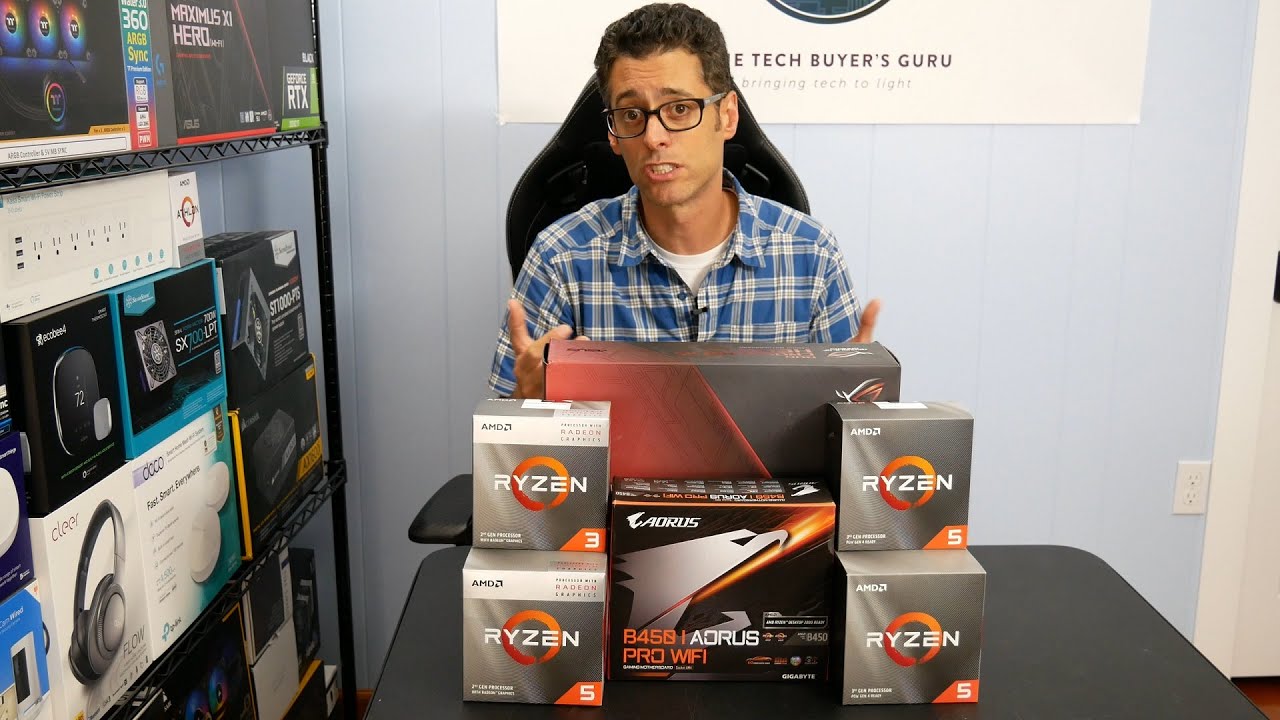AMD’s Ryzen 3 3200G and Ryzen 5 3400G Review
Pros
Cons
Rating
Introduction
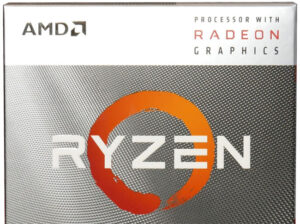 Not so long ago, we had a chance to test AMD’s first Athlon APUs based on the Zen architecture, and while we thought they had a place in the market, we weren’t blown away. AMD had done just enough to beat Intel in terms of value in the budget market, but this wasn’t saying much. Luckily, AMD also had its Ryzen “APUs” to deliver a serious bargain, in the form of the Ryzen 3 2200G and Ryzen 5 2400G, and these are the CPUs we’ve been recommending for over a year in our DIY PC Buyer’s Guides. Now AMD is back with the follow-up to these processors, the Ryzen 3 3200G and Ryzen 5 3400G, and we’re excited to bring you a full review of these promising contenders in the value market.
Not so long ago, we had a chance to test AMD’s first Athlon APUs based on the Zen architecture, and while we thought they had a place in the market, we weren’t blown away. AMD had done just enough to beat Intel in terms of value in the budget market, but this wasn’t saying much. Luckily, AMD also had its Ryzen “APUs” to deliver a serious bargain, in the form of the Ryzen 3 2200G and Ryzen 5 2400G, and these are the CPUs we’ve been recommending for over a year in our DIY PC Buyer’s Guides. Now AMD is back with the follow-up to these processors, the Ryzen 3 3200G and Ryzen 5 3400G, and we’re excited to bring you a full review of these promising contenders in the value market.
But, first, some background on what APUs are. In AMD’s world, an APU is a CPU with built-in graphics. To the rest of the world, this is just a CPU, and most Intel CPUs in fact do have built-in graphics. With that said, AMD is understandably proud of its APUs, because they have graphics chips derived from AMD’s powerful Vega architecture used in high-end desktop GPUs. That’s what made the 2200G and 2400G truly groundbreaking. The big question here is what improvements the 3200G and 3400G bring to the table. First, they’re based on the Zen+ architecture, which uses a more efficient 12nm manufacturing node (down from 14nm) for lower power use, while also offering slightly tweaked architecture, (on the order of 3% higher performance per clock). But perhaps the biggest difference is one that took the least ‘innovation: higher-clocked versions of the same Vega 8 and 11 graphics chips that appeared on the 2200G and 2400G, respectively. With clock speeds that are about 12% higher, this improvement could be viewed as the most significant in this new product release. Perhaps not revolutionary, but any improvement is admirable given that Intel has been going backwards in this market for a long, long time – in fact, it’s essentially abandoned the market all together!
Given their slightly-bumped specs, the 3200G and 3400G build upon the reputation of the 2200G and 2400G, which were already the best “do-it-all” processors on the market. But are they worth getting excited about? That’s what we aim to find out!
Special thanks to AMD for providing samples of its Ryzen 3 3200G and Ryzen 5 3400G for review.
Test Setup
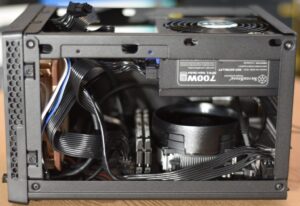 The system we used for our benchmarking had the following specs, and is pictured at right:
The system we used for our benchmarking had the following specs, and is pictured at right:
- Motherboard: Gigabyte B450 I Gaming
- RAM: G.Skill 2x8GB Sniper X DDR4-3400
- SSD: Samsung 860 Evo 500GB
- Case: SilverStone SG13
- Operating System: Windows 10
Note that we purchased a mini-ITX motherboard at retail specifically for purposes of this review, because we strongly believe that the best use case for the “G” series APUs is in small form factor systems. Thus all of our testing was done on this system. For comparison purposes, we have a number of other CPUs in our benchmarks. On the Intel side, we have the classic Core i7-6700K quad-core, which delivered the “Skylake” architecture to the market in 2015, which still forms the basis of all Intel CPUs available today. It also may be the closest thing to a model for today’s Ryzen 5 3400G. We also have the latest incarnation of the “Lake” series, the Core i9-9900K eight-core processor, more for purposes of comparing onboard graphics, as at $500, it’s really in a different league than the APUs. On the AMD side, we have a pair of Athlon dual-core processors in a number of our benchmarks to represent the ultra-budget market, and we also have AMD’s Ryzen 2700X eight-core CPU, which uses the same architecture as the 3000-series quad-core APUs, and should theoretically be up to 2x as fast. Finally, we have the new Ryzen 5 3600 and Ryzen 5 3600X, which will show you what AMD’s latest and greatest architecture offers. Yes, their names sound similar to the APUs, but they are in fact completely different, starting with a lack of onboard graphics. In other words, they aren’t playing in the same market.
Now, to give you a close look at the coolers you get in the box with these two Ryzen processors, as well as the benefits and drawbacks of AMD’s AM4 platform, we put together a comprehensive introductory video, which you can view right here:
All right, with that covered, let’s get into our testing!
The CPU Benchmarks
On this page, we provide benchmark results from four respected benchmarking utilities: 3DMark representing math-intensive physics, GeekBench representing typical office tasks, and Cinebench and V-Ray, representing content creation.
3DMark Fire Strike Physics
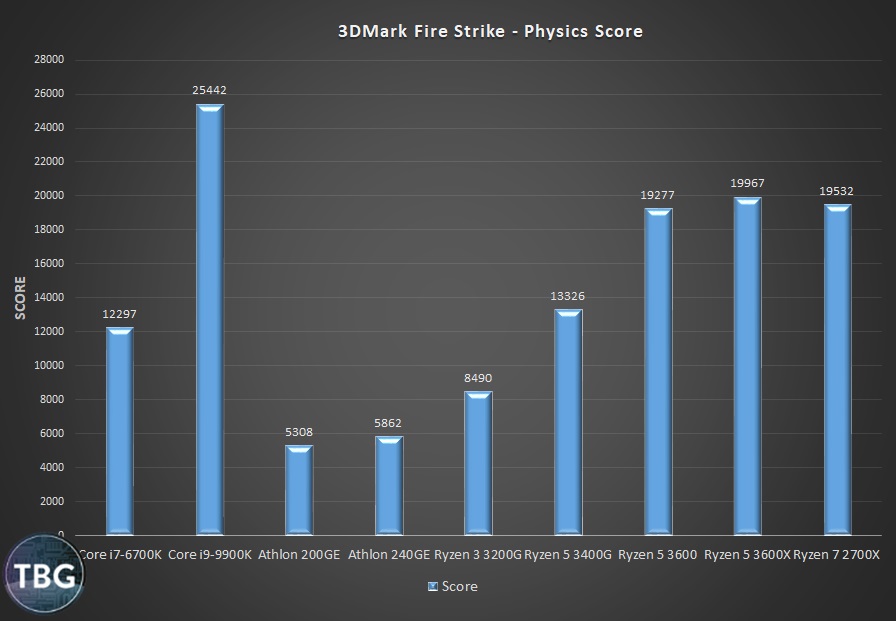
As you can see, there’s a definite hierarchy among AMD’s APUs and CPUs, and while the Ryzen APUs can’t challenge the mighty Core i9-9900K, it’s amazing to see the Ryzen 5 3400G beat the Core i7-6700K here. Consider that in 2015, the 6700K was Intel’s best mainstream processor, and came in at around $350. The 3400G is faster here, and comes in at just $150. That’s the kind of progress we like to see, but do keep in mind that’s it’s taken nearly four years to get this improvement in performance per dollar, an issue we’ll return to in the conclusion. With that said, the 3400G is 2.5x faster than the Athlon processors, which cost about $60 each. Amazingly, the 3400G’s price is exactly 2.5X that of the Athlons. We consider that very impressive – you usually get diminishing returns as you go up a product stack.
Another thing to take note of here is how the 3200G and 3400G differ from each other. The 3200G is a 3.6GHz with boost to 4GHz, while the 3400G is a 3.7GHz processor that boosts to 4.2GHz. But truth be told, those clockspeed differences are almost entirely irrelevant. The big difference is that the 3400G offers “simultaneous multithreading”, or SMT, which means for each physical core, there is another virtual core. Intel calls this Hyperthreading, and in Intel CPUs like the 6700K and 9900K, it boosts the Physics Score by exactly 50%, according to our tests. The 3400G is actually 57% faster here, which considering its slightly clockspeed advantage, means that SMT is just as effective as Hyperthreading, if not slightly more so.
GeekBench
This is a good test of overall PC performance, simulating a variety of common tasks. It offers both a single-core and multi-core score.
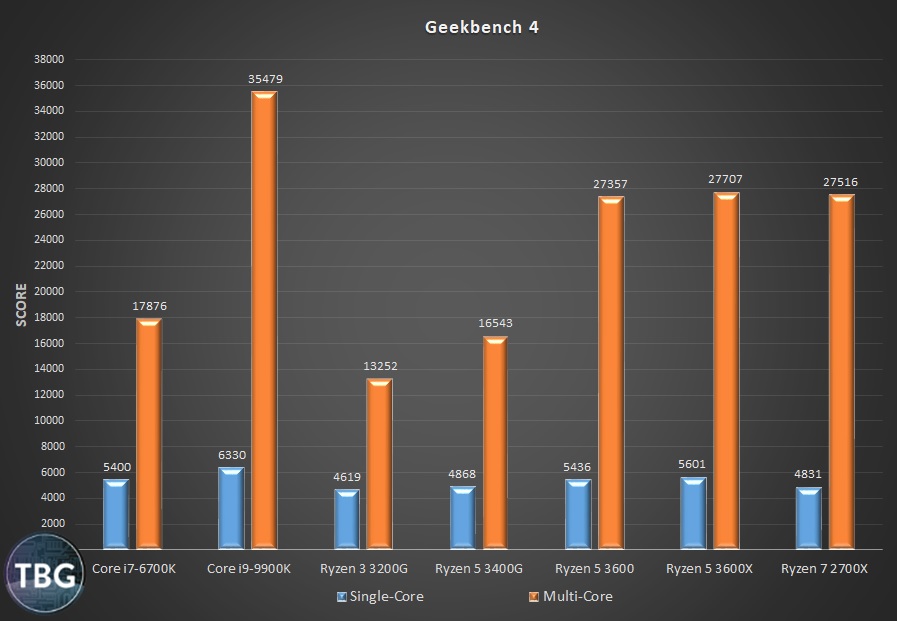
Again, wee see that the 9900K is way ahead, but that’s not what’s interesting about this result. Instead, it’s that the Zen+ architecture of the Ryzen APUs just can’t quite keep up with the Core i7-6700K of 2015. The single-core score of the 3400G trails that processor by about 10%. Keep in mind that the Ryzen 7 2700X is essentially two Ryzen 5 3400G CPUs put together, which is why its single-core score is nearly identical (its multi-core score isn’t quite double, but it’s close). The only AMD CPUs that can really keep with Intel’s Skylake architecture are the Zen 2-based Ryzen 5 3600 and 3600X.
Cinebench R15
This is a great test of rendering of 3D material, timing how long it takes each processor to render a scene, and then converting that into a score. It’s basically like a 0-60mph time for CPUs!
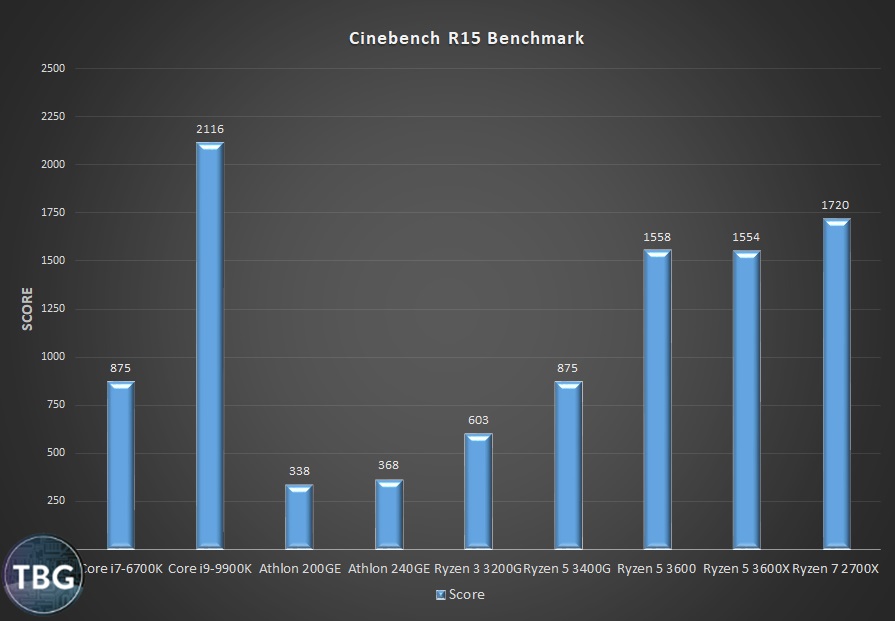
Cinebench happens to be fairly AMD-friendly. It was one of the benchmarks first “leaked” by AMD when it launched the Ryzen line in 2017. Yet despite that, the 3400G simply ties the 4-year-old 6700K. We would have liked to see it beat that 4GHz quad-core processor. In essence, it is the 2019 version of the 6700K for $200 less, which is fine, but not mind-blowing. At least the Ryzen APUs show why they are so much better choices than the Athlons for anyone not on a very strict budget, offering performance boosts in keeping with their additional cost. Notably, the 2700X is about twice as fast as the 3400G, another indication that this 2018 processor has basically been cut in half for use in the 3400G.
V-Ray
V-Ray is another take on rendering, this time providing a measure of all the work that a processor can do in one minute. It’s sort of like the equivalent of the “quarter mile” in car reviews!
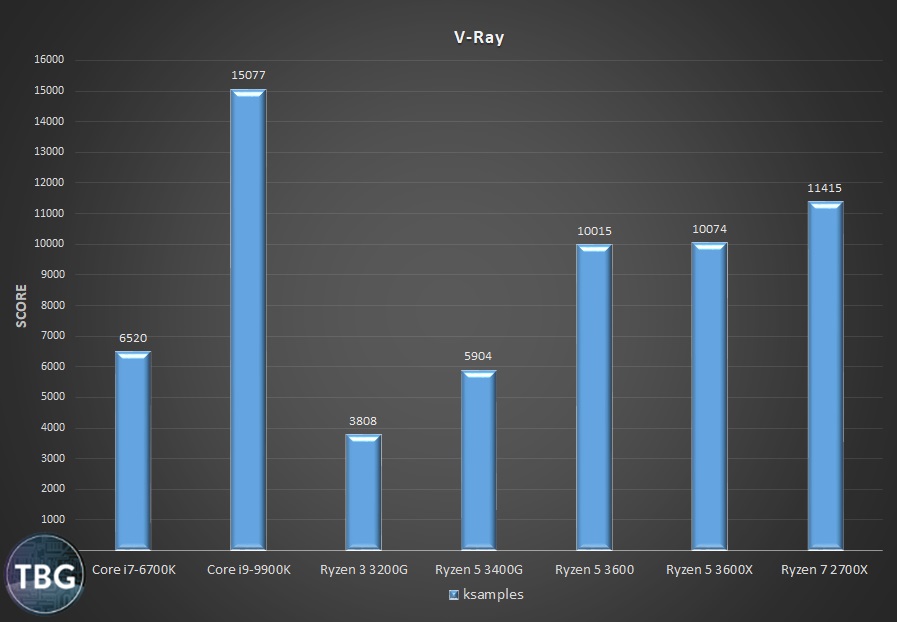
And here, Intel proves dominant, as the 3400G simply can’t keep pace with its Intel doppelganger, the 6700K. We do appreciate, however, that the 3400G at least offers 55% better performance than the 3200G, for only 50% more money. One issue, however, is that the Ryzen 5 3600, which is only 33% more money, offers 70% better performance. We’ll return to this topic in the conclusion as well, as it makes the 3600 appear to be the better choice if you don’t need the built-in Vega graphics.
With that said, let’s see what the Vega graphics can do in our gaming benchmarks.
Gaming Benchmarks
For these benchmarks, we set aside our Ryzen 5 3600, 3600X, and Ryzen 7 2700X, as these CPUs have no built-in graphics. Instead, we’ll focus on how the Ryzen APUs do versus Intel’s 6700K and 9900K processors, which use what Intel refers to as UHD 530 Graphics and 630 Graphics, respectively. They are essentially exactly the same thing, just ported over from 2015 to 2019. We also have some Athlon data in a few of the benchmarks, which use “Vega 3” graphics, which is quite literally 3/8ths of the Vega 8 Graphics in the 3200G, and 3/11ths of the Vega 11 graphics in the 3400G.
3DMark Fire Strike Graphics
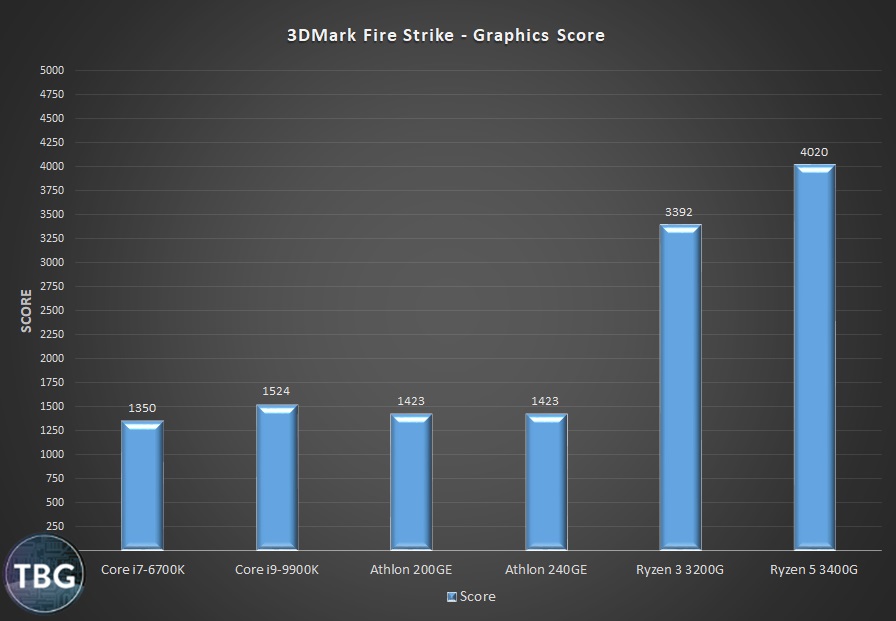
Oh, how the tables have turned. With AMD’s $60 Athlons nearly matching the GPU power of the $500 Core i9-9900K, you have to wonder why Intel even bothers. And in fact, some folks at Intel probably started wondering the same thing, which is why the company now sells the GPU-less Core i9-9900KF. For office PCs, the onboard Intel graphics are fine, but for gaming, they’re useless. We start with the Graphics portion of the 3DMark Fire Strike benchmark that we introduced on the previous page.
Of course, that also means that the Athlons aren’t particularly good, but at least they don’t cost all that much. Luckily, you get a whole lot more gaming performance for your dollar with the 3200G (it’s 2.4x faster), while the Ryzen 5 3400G is 2.4 faster. But how does that translate to actual games? Well, we have a couple benchmarks to show you on that too…
Rocket League
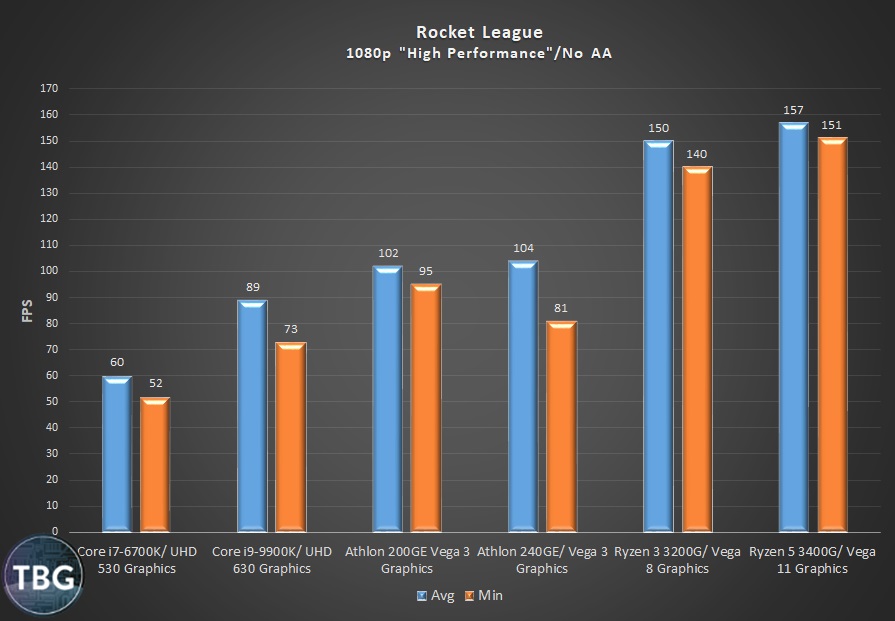
Rocket League is a popular eSports title, in part because it is so incredibly accessible. Able to hit 60fps on low settings with the 6700K, it’s truly playable on any modern CPU with built-in graphics. In fact, we’d bet that the developers of Rocket League actually designed the game’s low quality settings to directly target the 60fps threshold on Intel CPUs. Of note, the 9900K is quite a bit faster here, which is a bit surprising given the nearly identical GPU onboard. Both systems used Corsair 16GB of DDR4-3000 RAM, so that isn’t the difference (note that onboard graphics always rely on system RAM for video memory, so this is indeed relevant). Perhaps having twice as many CPU cores just allow the GPU to have easier access to data when it’s ready to process frames. Whatever the case may be, both Intel processors fall to AMD’s lowly Athlons, which are simply superior here. Sadly, the Ryzen APUs don’t maintain their 2-3x performance delta, only hitting around 150fps in this title. We were particularly disappointed in the 3400G, which seems to be running out of something, potentially memory bandwidth. Recall that both of these systems used fast DDR4-3400 RAM, but that may become a limiting factor at high framerates.
One thing we should note is that Rocket League looks terrible at low quality settings, so anyone with a Ryzen APU will likely want to sacrifice a few frame per second to take advantage of the power of the onboard Vega graphics. In other words, don’t play at low quality settings unless you absolutely have to!
DOOM (2016)
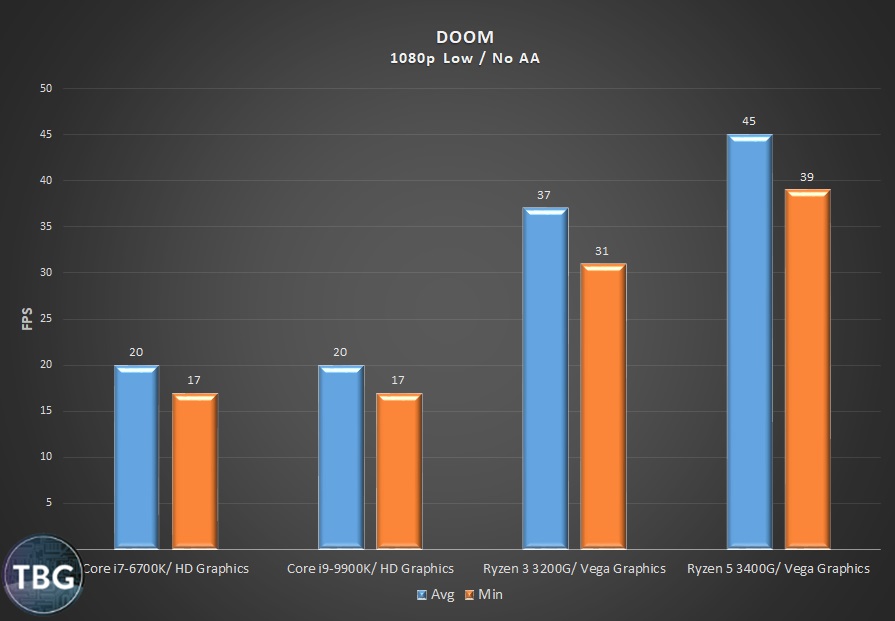
So this one is a bit of a challenge for all of our processors, and we dropped the Athlons, because there just isn’t much point gaming on them. DOOM uses a miraculously efficient game engine, and actually maintains some vestige of image quality even at low settings. Both the 3200G and 3400G are relatively playable, making them infinitely better choices than anything Intel has to offer. Note that the 3400G is about 22% faster than the 3200G, which is a bit disappointing given that its Vega 11 graphics has about 40% more theoretical power than the Vega 8 chip when taking into consideration both cores and clockspeed.
Power Use
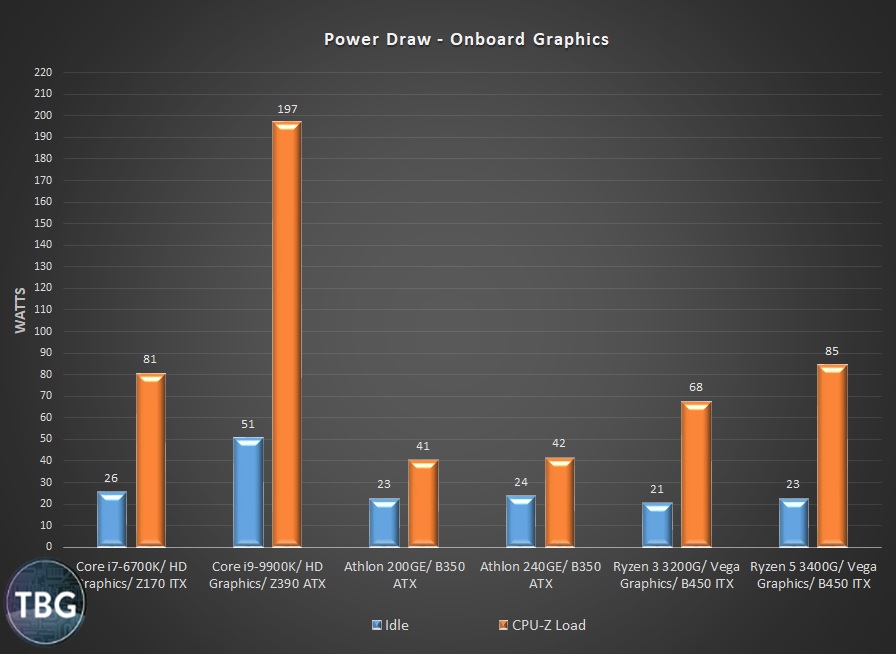
Finally, we get to power use, which is actually a pretty important factor when building a small gaming system (or really any small system). And here we see that AMD’s Zen+ architecture is every bit the equal of Intel Skylake architecture. Note how the 3400G essentially ties the 6700K in terms of power use. That’s a major win for AMD, given how far behind it was for the longest time. One thing to note in this benchmark is that the motherboard makes a huge difference, so the Athlon processors and especially the 9900K, which were all tested on full-size ATX motherboards, had a disadvantage in this comparison.
One issue we have to mention is that the Ryzen 5 3400G, which is rated at 65W, is clearly exceeding its 65W TDP rating. We think it’s essentially equivalent to the Core i7-6700K, which is rated by Intel at 91W. Alas, Intel has begun playing loose with the numbers as well, rating its 9900K at a ludicrous 95W, despite it being at least a 150W processor. Long story short, for PC builders looking to use ultra-compact cases with 100W to 150W-class power supplies, we’d be a bit wary of the 3400G as well as any of Intel’s Core chips.
Conclusion
In the current budget CPU marketplace, AMD can’t help but win against Intel, which has essentially stopped competing for customers under the $150 pricepoint. With that said, just beating Intel isn’t good enough, and that’s where we believe AMD could actually do better. In fact, as our benchmarks of the Ryzen 5 3600 and 3600X included in this review suggest, the answer is right in front of us: AMD should be using its more advanced Zen 2 architecture for its APUs, rather than the older Zen+ design. The fact that AMD’s APUs were ever split off from the normal cadence of the Ryzen rollout is simply a mistake of history. The original 2200G and 2400G were released in February 2018, but used the architecture of the Ryzen 1000 series that debuted in March 2017. We believe the only reason this happened was that the Vega graphics chip wasn’t ready for release in 2017. But AMD really had no excuse to then release the next iteration of its APUs nearly a year and a half later (in July 2019), with the already outdated Zen+ architecture that debuted in April 2018. Frankly, the 3200G and 3400G are what the original 2200G and 2400G should have been, and likely could have been had AMD just delayed the release of its APUs a few more months. Waiting until mid-2019 for this mild refresh seems to be asking too much of consumers and enthusiasts.
We believe the real winner in AMD’s current lineup is the Ryzen 5 3600, and we’ll be following up this review with a full review of that chip, as well as its cousin the 3600X. AMD’s Zen 2-based CPUs were worth waiting for, which can’t really be said of the 3200G and 3400G, which only match Intel’s offerings from 2015. Given that they also require an expensive X570-based motherboard for out-of-the-box firmware support, they are basically non-starters in our book. With that said, between the two, we like the 3200G more, as its $100 pricepoint is quite attractive for a low-cost PC, and it offers nearly the same gaming performance as the much more expensive 3400G. We also found its included 56mm-tall Wraith Stealth cooler to be much quieter than the 3400G’s 72mm-tall Wraith Spire, as well as far more likely to fit in compact system. Yes, the 3400G throws in SMT to increase its CPU performance, but if that’s what you’re after, pick up a Ryzen 5 2400G at a discount instead. In fact, at its current price of $120, it’s a far better choice than either the 3200G or the 3400G, and as an added perk, it can boot up on less expensive B450-based motherboard (and comes with the quieter Wraith Stealth cooler too). Indeed, the 2400G ends up being the winner of this review, despite not even appearing in the benchmarks!
As always, to get our recommendations on the best PC builds at every price point, see our Do-It-Yourself PC Buyer’s Guides!


